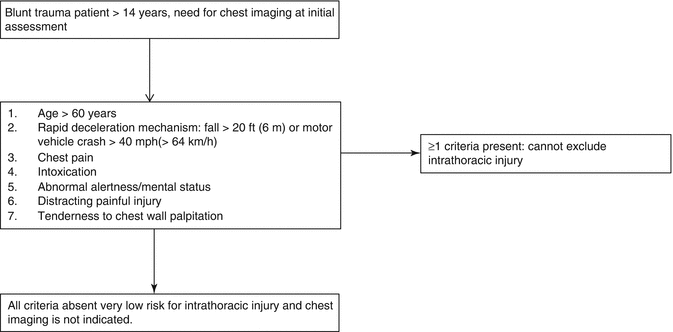Acute life threatening
Tension pneumothorax
Open pneumothorax
Flail chest and pulmonary contusion
Massive hemothorax
Cardiac tamponade
Potentially life threatening thoracic injuries
Simple pneumothorax
Hemothorax
Pulmonary contusion
Tracheobronchial tree rupture
Blunt cardiac injury
Traumatic aortic disruption
Traumatic diaphragmatic injury
Esophageal rupture
8.1.2 Trauma Mechanism and Pathophysiology
Chest trauma is mostly related to automobile or pedestrian accidents and commonly results in chest wall injuries like rib fractures. The pain associated with these injuries can make breathing difficult and this may compromise ventilation. This can be further aggravated by pulmonary contusion, which leads to even more difficulty in respiration. Shunting and dead space ventilation produced by these injuries can also impair oxygenation. Space-occupying conditions include pneumothorax, hemothorax, and hemopneumothorax. These interfere with oxygenation and ventilation by compressing otherwise healthy lung parenchyma. At a cellular level, lung contusion induces an inflammatory response signified by primed polymorph neutrophil granulocytes (PMNs) in blood and tissue [4].
Operative treatment is rarely necessary in blunt thoracic injuries although the advent of several plating systems for rib fixation increases intervention rates (see also rib fractures). Most blunt thoracic injuries can be treated with supportive measures and simple interventional procedures such as chest drainage. Traumatic asphyxia results from a severe blunt injury of the thorax. Patients present with cyanosis of the head and neck, subconjunctival hemorrhage, periorbital ecchymosis, petechiae of the head and neck, and occasionally neurologic symptoms. Factors implicated in the development of these striking physical characteristics include thoraco-abdominal compression after deep inspiration against a closed glottis. This results in venous hypertension in the valveless cervicofacial venous system. Other injuries caused by blunt thoracic trauma are diaphragmatic injuries, pneumothorax, hemothorax, blunt tracheal injuries, bronchial injuries, esophageal injuries, cardiac injuries, and injuries to the major thoracic veins or thoracic duct. These injuries and their management will be described in this chapter.
8.1.3 Classification
In the poly-traumatized patient chest trauma is only one part of all injuries. The evaluation of injury severity and the prediction of outcome is one of the most important functions of scoring systems. Several scoring systems for the classification of blunt thoracic trauma have been developed. The Abbreviated Injury Scale (AIS) is a prognostic scoring system allocating a severity score to every injury of the different body regions (Head, face, neck, thorax, abdomen, spine, upper extremity, lower extremity, external and other trauma). High scores are associated with a lower probability of survival. The AIS is an anatomical scoring system for injury severity assessment of different body regions [5, 6].
Most of the thoracic trauma scores are based on pathological-anatomical changes. The Thoracic Trauma Severity Score (TTS score) seems to be the most suitable for severity assessment and prediction of outcome in poly-traumatized patients with blunt chest injuries [7].
The TTS score is based on five anatomical and physiological parameters: pO2/FiO2, rib fractures, pulmonary contusion, pleural lesions, and age. Each parameter is assigned a value of 0–5. The TTS score ranges from 0 to 25 and with increasing values, a more severe thoracic trauma can be assumed (Table 8.2) [8].
Grade | PO2/FiO2 | Rib fractures | Pulmonary contusion | Pleural lesion | Age (years) | Points |
|---|---|---|---|---|---|---|
0 | >400 | 0 | None | None | <30 | 0 |
I | 300–400 | 1–3 unilateral | 1 lobe unilateral | Pneumothorax | 30–40 | 1 |
II | 200–300 | 4–6 unilateral | 1 lobe bilateral or 2 lobes unilateral | Hemothorax/hemopneumothorax unilateral | 41–54 | 2 |
III | 150–200 | >3 bilateral | <2 lobes bilateral | Hemothorax/hemopneumothorax bilateral | 55–70 | 3 |
IV | <150 | Flail chest | ≥2 lobes bilateral | Tension pneumothorax | >70 | 5 |
8.2 Diagnostics
Thoracic trauma may result in a variety of different injuries. A prompt assessment of correct diagnosis and severity assessment of thoracic trauma is crucial for the further treatment of thoracic lesions itself and concomitant injuries. There are several diagnostic tools for diagnosis and severity assessment of thoracic trauma.
8.2.1 Chest Radiography
The supine anteroposterior (AP) chest radiography is the initial examination of choice in patients with thoracic trauma. Because of the supine position of the trauma patient in the emergency room there is no lateral view available and therefore limited information can be gained from chest radiography. The chest X-ray is used as a first screening method during the evaluation of the trauma patient at the emergency room. The availability of CT scan, even in the emergency room, lead to a reduction in the need for plain films [9]. Although the CT scan is significantly more effective in detecting thoracic injuries, chest radiography still is recommended by Advanced Trauma Life Support protocol [3]. Especially in unstable patients a chest radiograph is still useful as it is the quickest way to rule out (tension) pneumothorax and hemothorax. CT scan is still more time consuming and requires considerable radiation exposure. Transferring an unstable patient from the emergency room to the radiology suite provides unnecessary risk. Overuse of CT scans can lead to inappropriate delays in patient care [10].
However, in the stable patient with suspicion of blunt thoracic injuries and an indication for chest CT scan, skipping the chest radiograph should be considered [11, 12].
In certain cases physicians even should not wait for a chest radiograph to confirm clinical suspicion. The classic example is hyperresonant note on percussion and the absence of breath sounds over the affected hemithorax combined with signs of hemodynamic compromise, which can be found in patients with tension pneumothorax. This should be immediately decompressed before obtaining a chest radiograph.
8.2.2 Computed Tomography of the Chest
The use of CT for thoracic trauma evaluation has increased dramatically in the past 15 years. Chest CT scan is superior in identifying and visualizing injuries like pulmonary contusions, pneumothorax, hemothorax, vascular injuries and fractures. In about 18–82 % of the patients with a normal chest X-ray additional injuries are found on chest CT scan [11–13].
The marked increase in the number of occult injuries diagnosed on a chest CT scan in patients with blunt thoracic trauma was not, however, accompanied by a similar increase in therapeutic intervention [14]. The disadvantages of a chest CT scan are exposure to radiation, costs and CT scan being more time consuming than a plain chest X-ray. Therefore it is important not to make a chest CT scan routinely but only when significant injuries are suspected.
Using the Nexus (National Emergency X-radiography Utilization study) Chest decision instrument might be helpful in decision-making in patients suffering from blunt thoracic trauma. The sensitivity and negative predictive value for thoracic injury seen on chest imaging was 98.8 and 98.5 % respectively [15]. This Nexus chest decision instrument is meant for all blunt trauma patients over 14 years old who, by initial assessment, may need chest imaging to rule out intrathoracic injury. The criteria used are age >60 years, rapid deceleration mechanism defined as fall >20 ft (>6 m) or motor vehicle crash >40 mph (>64 km/h), chest pain, intoxication, abnormal alertness/mental status, distracting painful injury, and tenderness to chest wall palpation. If all criteria are absent there is a very low risk for intrathoracic injury and chest imaging is not indicated. If one or more criteria are present, intrathoracic injury cannot be excluded and chest imaging should be done (Fig. 8.1) [15].
8.2.3 Ultrasonography
8.2.3.1 Transthoracic Ultrasonography
The Focused Abdominal Sonography for Trauma (FAST) is a rapid ultrasound examination performed in the emergency room. Except for abdominal injuries some thoracic injuries as hemothorax, pneumothorax, and blood in the pericardium can be reliably diagnosed with a sensitivity of 93–96 %. Most trauma patients are usually managed in the supine position with spinal immobilization, which underestimates the prevalence of thoracic lesion on chest X-ray. Especially in unstable high-risk patients thoracic ultrasonography as a bedside diagnostic modality is a better diagnostic test than clinical examination and chest X-ray together [16, 17]. However in the evaluation of pneumothorax the accuracy is not sustained over time, probably as a result of the formation of intrapleural adhesions [18]. As another disadvantage, subcutaneous emphysema precludes an accurate diagnosis by ultrasound.
8.2.3.2 Transesophageal Echocardiography (TEE)
In the workup of possible blunt rupture of thoracic aorta, transesophageal echocardiography has sensitivity and specificity up to 93–96 % in diagnosing a thoracic aorta rupture [19]. TEE also may help define intracardiac anatomy, function, and injuries like cardiac valve injury or traumatic rupture of the interatrial or interventricular septum. The TEE has a better sensitivity and specificity than the transthoracic echocardiography (TTE) for depicting aortic injury, pericardial effusion, myocardial contusion, atrial laceration, and cardiac valve injury [20]. However, the use of the TEE may be limited in patients with severe trauma and hypotension, or head, neck, and spine injuries [21].
8.2.4 Bronchoscopy
Fiber optic or rigid bronchoscopy is performed in thoracic trauma patients with suspicion for tracheobronchial injuries. Both techniques have high sensitivity for the diagnosis of these injuries. Bronchoscopy can be used in detecting tracheobronchial lesions, supraglottic injuries, bleeding, and lung contusions. Bronchoscopy can also be of therapeutic use for removing secretions and preventing the formation of atelectasis. Bronchoscopy is rarely used in the primary treatment of patient with thoracic trauma, but a few days after initial trauma it can be useful.
8.3 Acute Life-Threatening Thoracic Injuries
8.3.1 Tension Pneumothorax
A tension pneumothorax occurs when a pneumothorax permits entry but no exit of air from the thoracic cavity (Fig. 8.2). This results in increase of the air in the pleural cavity but leads to collapse of the ipsilateral lung and compression of the intrathoracic structures on the contralateral side. Although needle decompression in the midclavicular line is the recommended method of initial treatment, the patency of this procedure has been a subject of debate. In a porcine model of tension pneumothorax, 58–64 % of the needle placement procedures failed in adequate decompression, compared to a 100 % success rate in thoracostomy tube placement [22].
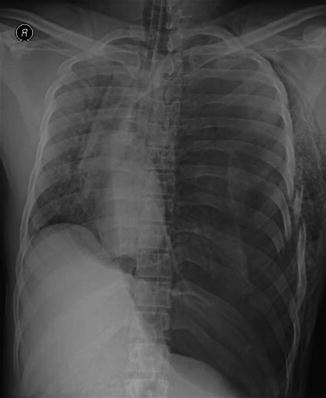

Fig. 8.2
Tension pneumothorax
In the acute clinical setting, a success rate of 59 % has been documented, while in the remaining 41 % the needle did not reach the pleural cavity [23]. Because of these flaws in needle thoracocentesis, blunt dissection and digital decompression should be the first step. When a chest tube cannot directly be placed, the incision is made in the midclavicular line in the second intercostal space, while in a later setting, a formal chest tube can be placed in the 4th intercostal space in the mid-axillary line [24]. In most cases chest tube placement is performed according the ATLS® guidelines [3]. An incision is made in the 4th or 5th intercostal space on the anterior axillary line, after which the pleura is bluntly opened. A large diameter (24–32 French) tube is inserted and placed dorso-cranially [25]. A canister with water seal is connected to the tube and wall suction is initiated. Preferably, prophylactic antibiotics are given; however, this should not delay the placement of a chest tube in an emergency setting [26].
8.3.2 Open Pneumothorax
An open pneumothorax occurs when a pneumothorax is associated with a chest wall defect (Fig. 8.3). During inspiration, air is sucked into the pleural cavity due to the negative intrathoracic pressure. When the diameter of the external wound is over 2/3 of the diameter of the bronchial tree then the air prefers to go through the wound. The wound has to be treated by a venting bandage. This can be applied using commercially available seals [27], or by applying a bandage, which is taped on three sides, allowing air to be vented out, but seals the cavity during inspiration [28].
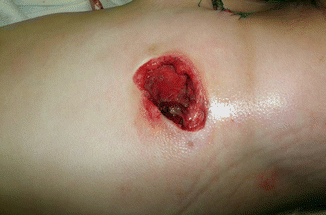

Fig. 8.3
Open pneumothorax
8.3.3 Massive Hemothorax
A hemothorax is defined as blood in the interpleural space. This occurs in up to 40 % of patients with blunt thoracic trauma. Bleeding is caused by parenchymal injuries, rib fractures, laceration of intercostal or internal mammary artery. Furthermore, hemothorax can be a life-threatening condition when caused by bleeding from the heart or hilar vessels.
All trauma patients with a hemothorax should undergo chest tube placement. In case of gross drain output, a second chest tube is placed promptly. Immediate surgery for massive hemothorax is mandatory when the patient’s physiology is unstable (persistent blood transfusion required), regardless of the numbers of initial chest tube output. Furthermore, when >1500 ml in the first 24 h is evacuated, it should prompt surgical intervention [29]. Injuries that are often found when massive hemothorax is present are bleeding from the azygos vein, the mammary artery, laceration of the hilar vessels, severe pulmonary tissue laceration, or dissection of the aorta. When having a massive hemothorax it should not be forgotten to re-infuse the lost blood by using the cell-saver.
8.3.4 Pulmonary Contusion
The most common injury after thoracic trauma is pulmonary contusion. It occurs in 30–75 % of all patients [30]. A severe lung contusion (Figs. 8.4 and 8.5) can be life threatening because of the destruction of alveolar architecture of the lung and intramural bleeding, prohibiting diffusion over the alveolar membrane, leading to severe hypoxia. The lung contusion will further be dealt with in Sect. 8.6.2.
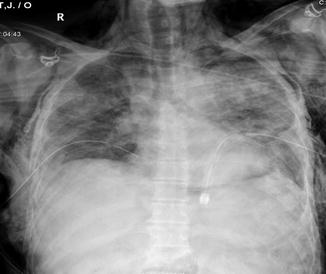
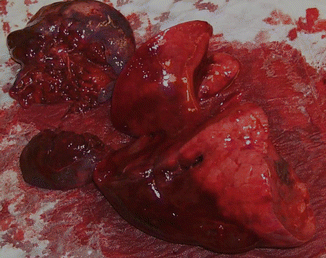

Fig. 8.4
Pulmonary contusion

Fig. 8.5
Lung tissue after pulmonary contusion
8.3.5 Cardiac Tamponade
A pericardial tamponade mostly occurs after penetrating trauma, but it also present in about 1 % of blunt chest trauma patients. It develops because of bleeding into the pericardial sac, either from an injury to the heart or from coronary or aorta lesion [31]. Immediate pericardiocentesis is indicated for restoration of normal cardiovascular function. Although successful outcome has been documented in pericardiocentesis as the sole procedure, in a patient with severe hemodynamic instability, the procedure is only to be used as a bridge to surgery or transfer to a definitive care facility [32]. An alternative is the performance of a subxyphoidal window to evacuate the blood from the pericardium. The definitive treatment consists of thoracotomy, repair of the injury causing the bleeding and adequate evacuation of the blood from the pericardium.
8.4 Potentially Life-Threatening Injuries
Besides the life-threatening injuries, which will lead immediately to death if left untreated, there are potentially life-threatening injuries in patients with thoracic trauma (Table 8.1). During the first minutes of trauma resuscitation these injuries can often be missed. So it is of great importance to have a high index of suspicion depending on the trauma mechanism and treat these injuries immediately to prevent further deterioration and eventually death. Additional imaging like a chest X-ray will help you in further diagnosis, however some of these injuries can easily be missed by conventional radiology alone (Sect. 8.2.1) [33].
8.4.1 Simple Pneumothorax
A simple pneumothorax occurs as a result of air entrapment into the pleural cavity between the two pleural layers (visceral and parietal) and will cause a (partial) collapse of the lung and thereby compromising oxygenation and ventilation on the affected side. The air leakage is often caused by a lung laceration after blunt thoracic trauma, but damage to the lung by rib fractures or penetrating injury can also account for this phenomenon.
Diminished breath sounds and hyperresonance to percussion over the affected hemithorax indicates the presence of a pneumothorax. In stable patients an additional chest X-ray or even a CT scan in the case of an occult pneumothorax is necessary to demonstrate the diagnosis. An occult pneumothorax is a pneumothorax that was not suspected clinically, nor was evident on the plain radiograph, but rather identified on CT scan or ultrasound. When adequate follow-up is provided (by means of ultrasound or chest X-rays), occult pneumothorax does not require chest tube drainage [34]. Even on positive pressure ventilation, conservative treatment of an occult pneumothorax can be successful and can reduce the length of hospital stay, given an adequate follow-up by ultrasound or chest radiographs [35–37].
The treatment of a pneumothorax will consist of a tube thoracostomy to release the air and thereby reexpand the collapsed lung. This tube should be placed according to the ATLS® recommendations [3]. Although some authors have stated the drainage of a simple traumatic pneumothorax in patients without other injuries can be done with a pigtail, we strongly suggest that this procedure should be reserved for a very selected patient population [38]. Since the majority of trauma patients with a pneumothorax (especially in blunt trauma) have concomitant injuries, which will often lead to persistent air leak and/or hemothorax, these patients require a formal chest tube. If left untreated a simple pneumothorax can convert into a tension pneumothorax and this certainly needs prompt intervention (see Sect. 8.3.1).
8.4.2 Hemothorax
A hemothorax occurs in up to 40 % of patients with blunt thoracic trauma. As a result of lung laceration, which damages the lung parenchyma, blood can enter the pleural cavity thereby causing a hemothorax. Both bleeding from an intercostal vessel or internal mammary vessel can also contribute to a hemothorax. Depending on the bleeding source and severity, the hemodynamical status of the patient will be influenced and should be treated accordingly. A hemothorax should be treated with a tube thoracostomy to evacuate the accumulated blood. The chest tube production should be monitored closely to recognize a massive hemothorax directly. No further immediate surgical intervention is necessary as a hemothorax is often self-limiting unless there is ongoing bleeding or there consists a massive hemothorax (see Sect. 8.3.3). By draining the intrathoracic hemorrhage the lung can reexpand and the formation of fibrous adhesions is prevented which reduces the risk of a pleural empyema and restrictive pulmonary disease [31, 39].
If a retained or persistent hemothorax is present a VATS is necessary to remove the clotted blood. The VATS procedure should be done within the first 3–7 days after trauma, in order to reduce the chance on conversion to thoracotomy and decrease the risk of infection [29]. Intrapleural thrombolytic therapy has only limited use and should not be considered as standard of care [40].
8.4.3 Tracheobronchial Tree Rupture
Injuries to the tracheobronchial tree (trachea or major bronchus) are rare and most patients die before they reach the hospital. They are frequently caused by blunt trauma which causes compression of the trachea between the sternum and vertebrae, or by a rapid deceleration trauma. Patients are in severe respiratory distress with coughing, stridor, or an altered voice and present with hemoptysis, massive subcutaneous emphysema, or associated pneumothorax.
A delay in diagnoses leads to a high mortality, even if the patient reaches the hospital alive. So if tracheobronchial injury is suspected immediate treatment is required. The first step is to establish a patent airway by endotracheal intubation. If the endotracheal tube can be managed distal to the tracheal injury, it can prevent a massive air leak (Fig. 8.6). Advantage is that there is no positive pressure in the injured lung; usually healing will appear without surgical intervention. A fiberoptic bronchoscopy can be used as a diagnostic adjunct and if a bronchial injury is diagnosed the tube can be placed in the contralateral bronchus. As the trachea and main bronchus are in the proximity of the great vessels and esophagus, associated injuries must be suspected and treated accordingly. In both tracheal and bronchial disruption further surgical repair is mandatory. When performing a thoracotomy it is possible to intubate directly in the ruptured bronchus (Fig. 8.7).
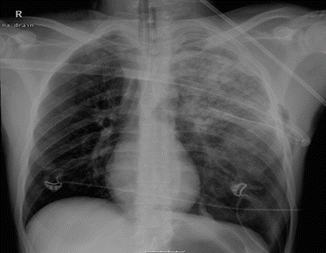
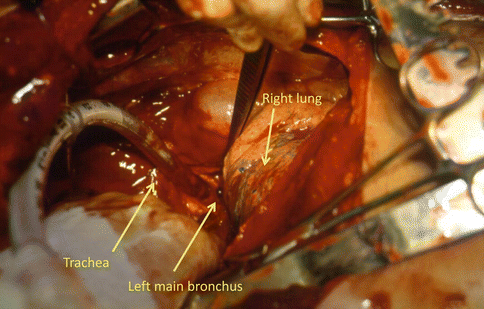

Fig. 8.6
Tube passes right-sided bronchial rupture

Fig. 8.7
Intubation through left bronchus
Tracheal lesions due to blunt trauma usually appear as transverse tears between cartilaginous tracheal rings or longitudinal tears in the posterior tracheal membrane. In tracheal injuries surgical repair is required in order to ensure airway continuity. This can be done by primary suturing with absorbable sutures or by the resection of several tracheal rings and re-anastomosis. Once this has been done, autogenous tissue is wrapped around the reconstructed trachea. In the neck, all strap muscles can be used for this procedure, while in the chest the intercostal muscles, serratus anterior, latissimus, or pericardial patches can be used.
8.4.4 Traumatic Aortic Disruption
Aortic injury caused by blunt trauma is mostly lethal at the scene; however, those that have only an intimal tear reach the hospital alive and so treatment can be established. In blunt trauma the shearing forces due to rapid deceleration will cause a partial laceration of the aortic wall near the ligamentum arteriosum. This will result in a contained rupture of the aorta (Fig. 8.8). Diagnosis is difficult as specific clinical signs are absent. Together with the trauma mechanism and a high index of suspicion an additional chest X-ray may reveal abnormalities like deviation of the trachea, widened mediastinum, or presence of an apical cap [3]. A CT angiogram of the aorta is more accurate and will confirm the diagnosis and the extent of the injury. Therapy consists of maintaining the mean arterial blood pressure around 60 mmHg, which will reduce the risk of rupture. Thereby it is possible to delay the nowadays often-used endovascular repair of the aortic injury (Figs. 8.9 and 8.10) while treating other severe associated injuries [41, 42].
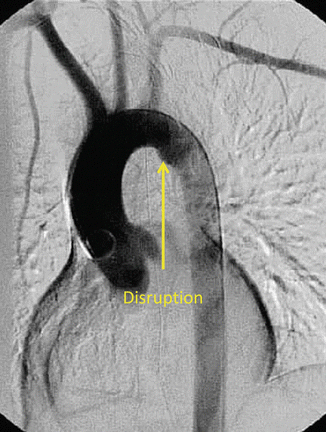
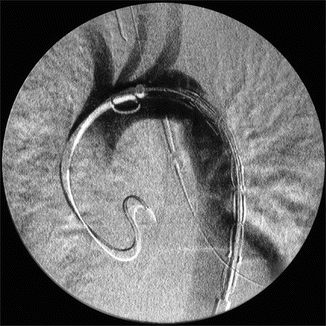
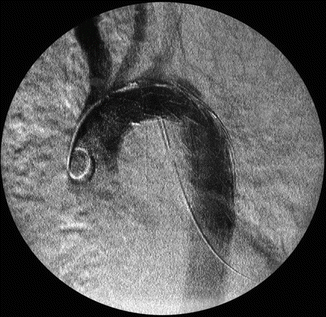

Fig. 8.8
Traumatic aortic disruption

Fig. 8.9
Stent positioning in aorta

Fig. 8.10
Stent in aorta after deployment
8.4.5 Traumatic Diaphragmatic Injury
Blunt torso injury produces large tears and predominantly occurs at the left hemidiaphragm. These tears can lead to herniation of intra-abdominal organs, which can be diagnosed on chest X-ray (Fig. 8.11). Diagnosis however is often hampered by the fact that the multiply injured patients are treated with positive pressure ventilation, which prevents dislocation of abdominal organs into the thorax. Nowadays early CT scanning can reveal the discrete changes that go with diaphragmatic injury. Many of the diaphragmatic injuries however are diagnosed during an emergency laparotomy or thoracotomy for associated intra-abdominal or intrathoracic injuries. The treatment exists of direct repair. Only in the minority of cases a mesh is necessary.
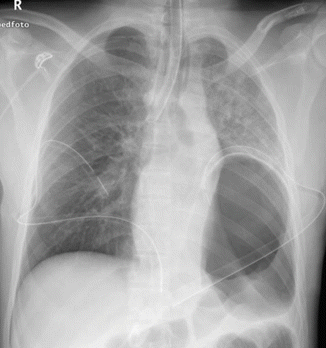

Fig. 8.11
Ruptured diaphragm
8.4.6 Esophageal Rupture
Blunt esophageal injuries are very rare. They are caused by a sudden increase in the intra-abdominal pressure, for example by a blow in the upper abdomen. Gastric contents will eject in the esophagus causing a rise in intraluminal pressure. Pressure rise can lead to a tear in the esophagus with leaking of content into the mediastinum.
Patients present with clinical signs like subcutaneous emphysema, pneumomediastinum, pneumothorax, or intra-abdominal free air. Time between trauma and definitive treatment may influence the outcome by developing esophageal injury related complications [43].
If diagnosed early, the majority of the patients can be treated with primary surgical repair and additional drainage of the mediastinum becomes necessary. Nowadays an endoscopic esophageal stent is a possible alternative [44]. If left undiagnosed patients often present with fever and signs of systemic sepsis caused by mediastinitis at a later stage.
8.5 Bone Injuries
8.5.1 Rib Fractures
Rib fractures are the most common thoracic injuries and occur in 10 % of all trauma patients and approximately 30 % of patients with significant chest trauma [45]. Fractures of the first and second rib suggest severe thoracic trauma. These ribs provide a protection of vital structures like brachial plexus and vessels (subclavian artery and vein). Ribs 4–10 are most frequently involved. The mechanism is often due to direct forces on the chest wall. With fractures of ribs 8–12 the presence of intra-abdominal injuries should be considered.
Physical signs of rib fractures include local tenderness and sometimes crepitus over the site of the fracture. Rib fractures may also by an indicator for other significant intrathoracic injuries. Elderly patients and patients with osteoporosis or osteopenia have an increased risk of number and severity of fractures. This is in contrast to children where higher forces are needed to cause fractures, because the chest wall is more pliable and compliant. The most common symptom of rib fractures is pain, which makes it difficult to breathe adequately. Up to 30 % of the patients with rib fractures develop a pneumonia; the older the patient the higher this percentage [46, 47]. The greater the number of fractured ribs the higher the mortality and morbidity [45]. Up to 10 % mortality is reported in patients with more than 4 rib fractures; this increases to 34 % in patients with 8 or more fractures [48]. It is also known that patients with more than 4 rib fractures after the age of 45 have an increased risk of adverse outcomes [48–51].
A flail chest can be defined as fractures of four or more consecutive ribs in two or more places resulting in paradoxical movement of the chest wall during respiration. Paradoxical movement of the chest can increase the work and pain involved with breathing. In most patients the severity and extent of the lung injury determines the clinical course and the requirement of mechanical ventilation. Patients with flail chest have a significant higher need for mechanical ventilation. Although the recovery of mechanical ventilation ensured a better result in the treatment of flail chest, it is also responsible for several ventilation related complications.
Management of rib fractures involves pain control and adequate oxygenation and ventilation possibly using positive pressure ventilation when necessary. In patients with a flail chest, non-operative treatment leads to a mortality of 25–51 and 27–70 % develop pneumonia [52]. External stability by means of operative fixation is an alternative treatment of multiple rib fractures in order to avoid mechanical ventilation (Figs. 8.12 and 8.13). The goal of operative therapy is to improve respiratory mechanics, reduce pain, and prevent pulmonary restriction associated with significant chest wall deformities. Current indication for operative fixation is the presence of a flail chest [53] which is associated with reduction in duration of mechanical ventilation, complications associated with prolonged mechanical ventilation, length of stay in the hospital and mortality [54].
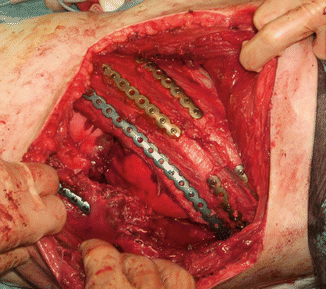
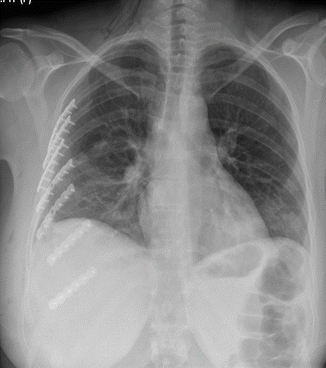

Fig. 8.12
Rib fiation: clinical scenaroi

Fig. 8.13
Rib fixation: xray post op
Other indications are patients with rib fractures who, notwithstanding good pain management, are still in pain, have chest wall deformity, or have one or more symptomatic non-union rib fractures. Age over 45 years and more than four rib fractures seem to be important factors in determining outcome of patients with multiple rib fractures. Therefore an operative approach of patients older than 45 years with four or more rib fractures should be considered.
8.5.2 Sternal Fractures
Sternal fractures are present in up to 8 % of the admissions after blunt thoracic trauma and motor vehicle crashes [55]. Before the use of the seatbelt a sternal fracture was a marker of high-energy trauma. With the mandatory use of a seatbelt, the survival after motor vehicle crashes increased together with a rise in the incidence of the sternal fracture, also called the typical “seat belt injury” [56].
The typical sternal fracture is a transverse fracture located in the upper and midportions of the sternal body. The symptoms consist of localized tenderness, swelling, and deformity. A sternal fracture can be diagnosed by a lateral view because a sternal fracture is rarely apparent on the anteroposterior chest film. The highest sensitivity is reached by the chest CT scan is.
As in all thoracic fractures, sternal fractures are often associated with more serious occult injuries. Underlying myocardial injury is not uncommon. Treatment of sternal fractures is similar to that for rib fractures. It consists primarily of pain control and appropriate pulmonary hygiene. Patients with isolated, stable sternal fractures that have normal radiographic findings and normal electrocardiograms can be treated as outpatients [57].
When the sternal fracture is severely displaced open reduction and internal fixation by a midline incision should be done. Various techniques are described, including wire suturing and the placement of plates and screws. Although there are several pre-contoured plates available for this aim, the less massive plates employed for rib fixation can also be used. In the presence of a flail chest a different approach can be followed to fixate both ribs and sternum.
8.5.3 Scapular Fractures
Fractures of the scapula are uncommon; they occur due to a high-energy dissipation. These patients usually have associated injuries (61 %) with higher treatment priority. The associated injuries reported most frequently are rib fractures including pneumothorax, hemothorax, pulmonary and spinal injuries.
A patient with a scapular fracture typically presents with the arm adducted along the body. In physical examination, swelling, crepitus, ecchymosis, and local tenderness may be present. Active range of motion is restricted in all directions. With the presence of a scapular fracture, arterial injury and/or brachial plexopathy should also be considered. Most fractures occur in body (30 %) and neck (25 %) and can be treated non-operatively. In contrast, displaced intraarticular fractures of glenoid mostly need operative fixation.
8.6 Lung Injuries
8.6.1 Pulmonary Lacerations
Pulmonary laceration can be the result of penetrating chest trauma. But also blunt injury, which causes penetration due to rib fractures or torn lung tissue as a result of shearing forces can lead to lacerations of the lung parenchyma. Lung lacerations are characterized by the disruption of the pulmonary architecture, which will cause air or blood leakage. If this ruptures through the visceral pleura it will lead to a pneumothorax, hemothorax, or both. When blood or air becomes entrapped in the lung parenchyma a traumatic cyst develops which will be called pulmonary hematoma or pneumatocele, respectively [58].
The only classification system for pulmonary lacerations published until now is from Wagner et al. (Table 8.3). They describe 4 types of lacerations based on CT findings or mechanism of injury: compression rupture, compression shear, rib penetration, and adhesion tears [59]. Treatment is often non-operative; however, depending on the grade and location, sometimes surgical treatment is necessary. A thoracotomy with preservation of the lung is the primary goal in combination with wedge resection and segmentectomy if required. In case of penetrating injury caused by rib fractures with a through and through tract, a pulmonary tractotomy can be performed (see Sect. 8.10, Figs. 8.14 and 8.15).
Type | Mechanism of injury | Appearance on CT

Full access? Get Clinical Tree
 Get Clinical Tree app for offline access
Get Clinical Tree app for offline access

|
|---|
